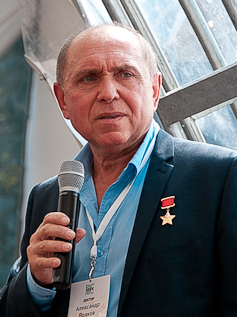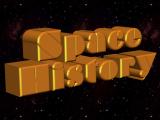If you are not already a subscriber, you are welcome to enter your email address here to sign up to receive the Space History newsletter on a daily basis. Under no circumstances will we release your legitimate email address entered here to outside persons or organizations, and it will only be used for mailing the specific information you have requested.
| Enter your email address here: |
Unsubscribe instructions are included in every newsletter issue in case you decide you no longer wish to receive it.
Note: We record the IP address from which subscriptions are entered to help prevent SPAM abuses.
Race To Space
Someone will win the prize...
... but at what cost?
Visit RaceToSpaceProject.com
to find out more!
1857
H. Goldschmidt discovered asteroid #44 Nysa.
1887
A. Charlois discovered asteroid #267 Tirza.
1918
Born, Theo Anton Poppel, German/American rocket ground support engineer, played a key role in conceiving and designing LC 34 for the Saturn I and the VAB and Transporter-Crawler at LC 39 for the Saturn V
ref: www.astronautix.com
1919
The United States Navy flying boat NC-4 arrived in Lisbon, Spain, completing the first transatlantic flight, having made multiple stops along the way during the 11 day journey.
ref: en.wikipedia.org
1931
In the first human ascent into the stratosphere, A. Piccard and C. Knipfer reached 15.78 km (51,770 feet) in a balloon.
ref: en.wikipedia.org
1931
The first full scale wind tunnel for testing airplanes was opened at Langley Field, Virginia.
ref: airandspace.si.edu
1945
The German rocket team provided directions to their American captors to the mine in the Harz Mountains where the technical documentation taken from Peenemuende was hidden. The Americans recovered 14 tons of V-2 documentation.
ref: www.astronautix.com
1948
Born, Aleksandr Aleksandrovich Volkov (at Gorlovka, Donetsk Oblast, Ukrainian SSR), Colonel Soviet AF Reserve, Soviet cosmonaut (Soyuz T-14, Mir 4, Mir 10; over 391d 11.75h total time in spaceflight)

Cosmonaut Aleksandr A. Volkov (3 August 2013)
Photo by Evgeny Salganik
Source: Wikipedia
ref: www.spacefacts.de
1948 14:16:00 GMT
APL launched V-2 Solar Ultraviolet/Chemical Release mission # 35 from Pad 33 at White Sands.
The Applied Physics Lab at John Hopkins University launched V-2 Solar Ultraviolet/Chemical Release mission # 35 from Pad 33 at White Sands, New Mexico. It reached an apogee of 139.7 km (86.8 mi) in a steady flight with a low roll rate. The mission carried APL experiments re. photography, cosmic and solar radiation, and experiments re. composition for the Signal Corps Engineering Lab at the University of Michigan.
ref: en.wikipedia.org
1958 03:46:00 GMT
The US Navy launched Vanguard SLV-1 for Earth orbit, but the mission failed when an unknown cause led to an improper third stage trajectory. The Lyman Alpha satellite reached an apogee of 3500 km.
ref: en.wikipedia.org
1969 12:59:00 GMT
USSR launched Cosmos 283 into orbit for investigation of the upper atmosphere and outer space.
ref: nssdc.gsfc.nasa.gov
1971 11:59:00 GMT
USSR launched Cosmos 423 into orbit from Plesetsk for investigation of the upper atmosphere and outer space.
ref: nssdc.gsfc.nasa.gov
1974 07:20:00 GMT
USSR launched Cosmos 656 from Baikonur, an unmanned test flight of the Soyuz 7K-T(A9) variant, designed for docking with the military Almaz space station, used in the Apollo-Soyuz Test Program (ASTP). The mission was successful.
ref: nssdc.gsfc.nasa.gov
1978 01:25:00 GMT
USSR atttempted to launch the #13L geosynchronous Ekran communications satellite from Baikonur, but the first stage thrust vectoring malfunctioned starting at T+87 seconds, and the satellite did not reach orbit.
ref: en.wikipedia.org
1981
A. Gilmore and P. Kilmartin discovered asteroid #2434 Bateson.
1982
C. and E. Shoemaker discovered asteroid #3194 Dorsey.
1984
C. and E. Shoemaker discovered asteroid #3671 Dionysius.
1986 09:36:00 GMT
USSR launched the Meteor 2-14 weather satellite from Plesetsk, for gathering meteorological information and data on penetrating radiation fluxes in circumterrestrial space.
ref: nssdc.gsfc.nasa.gov
1988
Died, Ernst August Friedrich Ruska, German physicist, (Nobel 1986 "for his fundamental work in electron optics, and for the design of the first electron microscope")
ref: www.nobelprize.org
1993 01:22:00 GMT
USSR launched the Gorizont 28 communication satellite toward geosynchronous orbit from Baikonur, but the second stage did not reach the planned velocity. The cause was determined to be propellant contamination.
ref: en.wikipedia.org
1999 05:50:00 CDT (GMT -5:00:00)
NASA launched STS 96 (Discovery) for the International Space Station (ISS) 2A.1 mission, the first docking of the Shuttle to the ISS.
On 27 May 1999, NASA launched the space shuttle Discovery as STS 96 to visit the new International Space Station (ISS) for six days of docked activities. This flight was the first shuttle docking at the fledgling space outpost. Its configuration at the time consisted of the PMA-2 docking port, NASA's Unity node, the NASA-owned, Russian-built Zarya module, and the PMA-1 docking unit connecting Unity and Zarya. Discovery docked at the PMA-2 end of the International Space Station on 29 May 1999.
The major objective of the mission was the transfer of almost two tons of logistical supplies to the ISS. The supplies were used to not only continue the outfitting of the Unity and Zarya modules already joined together in orbit, but for use by a subsequent Shuttle assembly crew to set up the Russian Service Module for occupancy by a three man crew early in 2000.
The seven crew members also collected data from an experiment designed to test the amount of vibration imparted on shuttle-based payloads, and began to demonstrate the effect of shuttle technological upgrades, through the use of orbiter health monitoring devices designed to improve the quality of life aboard future shuttles while making their use more efficient.
The first major task for the shuttle astronauts was a spacewalk to outfit the Zarya and Unity Modules and the mating adapter to which they are attached. Astronauts Tamara Jernigan and Daniel Barry conducted a 7 hour, 55 minute spacewalk in support of International Space Station assembly on 30 May 1999. Their assignments included installing foot restraints, handrails and tool bags for use by future spacewalkers on the station. They also installed two cranes and an insulating cover, and then inspected an early communications system on the Unity Module: The ODS/EAL docking/airlock truss carried two TSA (Tool Stowage Assembly) packets with space walk tools. The Integrated Cargo Carrier (ICC), built by Energia and DASA-Bremen, carried parts of the Strela crane and the US OTD crane, as well as the SHOSS box containing three bags of tools and equipment to store on ISS's exterior.
After the EVA, the crew focused on transferring nearly 1,360 kilograms (3,000 pounds) of equipment from the shuttle to the ISS for use by future station crews. They transferred equipment from the Spacehab Logistics Double Module in the shuttle's payload bay to the interior of the station. The crew also replaced battery recharge controller modules in the six batteries stored inside the Zarya Module. A power distribution unit and transceiver in the Unity Module was replaced, enabling controllers from Mission Control in Houston, Texas to send comands to the station via an Early Communications System.
Discovery undocked from the ISS on 3 June, leaving the station without a crew aboard, as planned.
On 5 June, the astronauts deployed a small satellite from the payload bay called STARSHINE, which was observed by international students on Earth as they calculated its precise orbit and the rate of its orbital decay over time.
STS 96 ended on 6 June 1999 when Discovery landed on Runway 15 at the Shuttle Landing Facility, Kennedy Space Center, Florida. It was the eleventh night landing in the shuttle program history as Discovery completed a 6.4-million kilometer (4-million mile) trek to resupply the ISS. Orbit altitude: 210 nautical miles. Orbit inclination: 51.6 degrees.
The flight crew for STS 96 was: Kent V. Rominger, Commander; Rick D. Husband, Pilot; Tamara E. Jernigan, Mission Specialist 1; Ellen Ochoa, Mission Specialist 2; Daniel T. Barry, Mission Specialist 3; Julie Payette, Mission Specialist 4; Valery Tokarev, Mission Specialist 5.
ref: www.nasa.gov
2018
Died (Alzheimer's, bone cancer), Donald H. Peterson (at El Lago, Texas, USA), Colonel USAF, NASA astronaut (STS 6; nearly 5d 0.5h in spaceflight)
ref: www.nasa.gov
We are going to run out of oil!
Visit SpacePowerNow.org
to help fix the problem.
SpacePowerNow.org - For Human Survival
Please help support our efforts by shopping from our sponsors.
This newsletter and its contents are Copyright © 2006-2025 by The L5 Development Group. All rights reserved. - Publication, in part or in whole, requires previous written permission. - Academic or personal-use citations must refer to http://L5Development.com as their source. Thank you for your cooperation.
Space History Department
Resources
The L5 Development Group Home Page
The L5 Development Group Keyword Access System
Space History for May 27 /
Webmaster /
Script last modified August 23, 2018 @ 6:05 am
Copyright © 2006-2025 by The L5 Development Group. All rights reserved.
Hosted by FKEinternet




